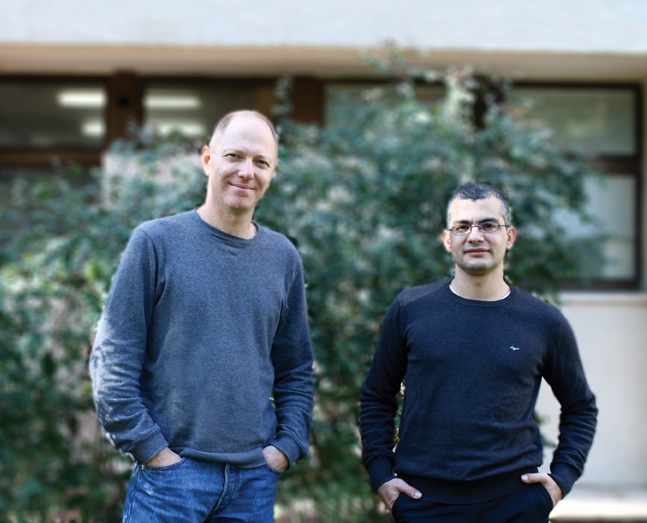A new study by Weizmann Institute of Science scientists, which is still at the beginning of the road, may pave a new path for the development of targeted healing methods against the disease, using a tiny genetic device

The journey to cure cancer - as journeys are - is difficult and tortuous, and includes hopeful ups, along with disappointing downs. A new study by Weizmann Institute of Science scientists, which is still at the beginning of the road, may pave a new path for the development of targeted healing methods against the disease, using a tiny genetic device. "We were able to demonstrate the idea with cell cultures in vitro," says Prof. Roi Bar-Ziv, from the Department of Materials and Surfaces in the Faculty of Chemistry, who headed the research team. "However, the great complexity of the human body - in relation to cell cultures - constitutes a huge challenge, requiring many and lengthy development stages, in order to implement the idea as an effective treatment for humans."
In order to save the lives of cancer patients, the surgeon has to remove the cancerous tumor without damaging the healthy tissues around it - a task that can be challenging. We also expect anti-cancer drugs to kill only the tumor cells and not healthy cells. But unfortunately, most of the drugs in use today destroy not only cancer cells, but also healthy cells, and cause serious side effects. The new generation of drugs is designed to act in such a way that they eliminate the cancer cells in a targeted and selective manner, and in this way reduce the side effects to a minimum.
In a study published recently in the scientific journal Molecular Systems Biology, Weizmann Institute of Science scientists reported that they succeeded in producing a tiny genetic sensor, made of a DNA circuit with three genes, which identifies cancer cells with great precision and kills them efficiently. The device, which was nicknamed DPI (dual-promoter integrator), was tested in vitro and found to be effective: not only does it identify and kill different cancer cells, but it can also assess the degree of "cancerousness" of the cell, thus distinguishing between pre-cancerous and cancerous cells .
"Knowledge of Research and Development" - the applied arm of the Weizmann Institute of Science - submitted a patent application for the method for the production of the nanodevice. Prof. Bar-Ziv: "Many studies and experiments will be required until we reach the stage where we can try and test the device on humans. Our hope is that in the future we will be able to use the artificial sensor as an independent 'nano-surgeon' that will be inserted into the body's cells, make decisions independently, and kill only the cancer cells."
The "nanodevice" identifies the cell as cancerous with the help of two DNA sequences found in its circuit. These are two "promoters", or "promoters": a kind of switches that promote the activity of the gene, and influence its level and its timing. Thus, for example, promoters of growth genes are involved in the development of a cancer tumor. When such promoters are in the "activated" state too often, or at a greater intensity than required, the cell becomes cancerous. Accordingly, the artificial device was programmed to measure the activity level of two such promoters. When both are overactive, it will recognize that it is a cancer cell.
When the artificial nanodevice is inserted into the cell, it reacts to its environment, imitating the behavior of the promoters found in the cell itself. If the cell is cancerous, and its promoters are in the "on" state, the two promoters in the sensor will also switch to the "on" state. As soon as the double activation occurs, the cell is identified as cancerous, and the device sends a signal to the third gene - the "killer" gene. This gene produces a toxic substance, which kills the cell.
In addition to its simplicity, the new nanodevice has several other great advantages compared to the gene therapy methods used today to cure cancer. Thus, in most gene therapy methods, the cancer cells are identified through a single genetic characterization, which often causes errors in identification, and the accidental destruction of healthy cells. The use of two genetic characterizations ensures a much more accurate identification. Furthermore, the artificial device can be tuned so that the "killer" gene will only respond when it receives a signal of a certain degree: that is, if the promoters - or even one of them - are acting weakly, it will not respond. Such an adjustment will be an additional security measure that will prevent the killing of healthy cells. In addition, it will make it possible to distinguish between pre-cancerous cells and cancerous cells: in cancerous cells, the growth signal is stronger.
The research was carried out by Dr. Lior Nissim during his doctoral thesis. Dr. Nissim completed his master's degree in cancer molecular biology under the guidance of Prof. Verda Rutter from the Weizmann Institute. Although the current research focused on cancer, the researchers expect that the modular nature of the nanosensor will allow it to be adapted to the treatment of other diseases, as well as for accurate sorting of cells in cultures, as an aid to scientific research.

4 תגובות
Kudos to Professor Roi Bar-Ziv and Dr. Lior Nissim!
Cool!
exciting.
Is it possible to schedule more or less?